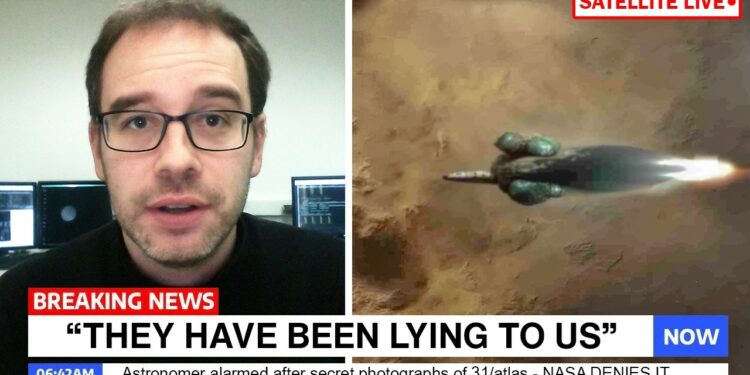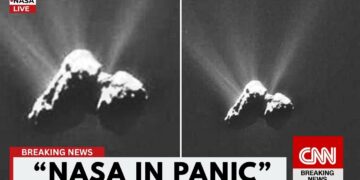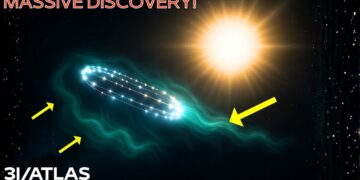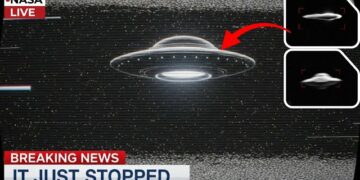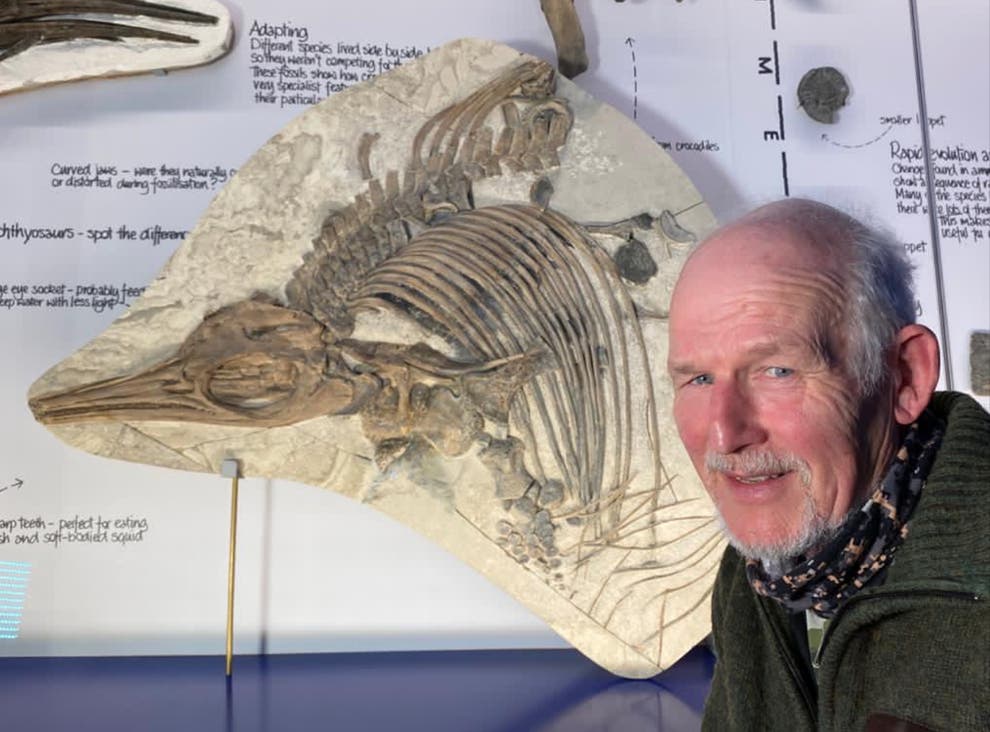We have new images of 3I/Atlas, the third interstellar object ever observed from Earth, currently speeding through our solar system. Astronomers have captured this moment live, streaming it in real time to viewers worldwide. Take a look.
There are images that reveal beauty, and others that reveal truth. This one does neither. At first glance, it appears to be a failure—a photograph that refuses to focus. But behind the blur lies something extraordinary: motion captured at the edge of physics, light gathered from a traveler that never belonged to our Sun. Every pixel in this image carries history, a trace of an object older than Earth, crossing our sky for the first and last time.
So, what does this image actually show? How do you hold still something that refuses to stay still? Capturing 3I/Atlas is not like photographing an ordinary comet. It moves too fast and shines too faintly for standard exposure techniques to work. By the time a telescope collects a few seconds of light, the object has already traveled thousands of kilometers through space. A single frame would show nothing but a soft streak—a comet-shaped guess stretched by its own motion.
To overcome this, the telescope had to chase it. Tracking software predicted the comet’s path second by second, adjusting the mount in near real time. The stars in the background blurred into trails, but 3I/Atlas held its position. What appears as a still blur in the final image is actually motion perfectly canceled out—a precise balance between the comet’s speed and the telescope’s pursuit. Even then, one exposure wasn’t enough. At magnitude 17, the comet is barely visible to the sensor. Astronomers stacked multiple long exposures, aligning them until the faint signal became coherent. Atmospheric tremors, instrument vibrations, and temperature changes were all filtered out. The shape that emerged was fragile but consistent: a faint cylinder of light, moving faster than our focus yet slow enough to be caught.
This isn’t just a photo—it’s time made visible. Every pixel carries minutes of motion, compressed and rebalanced until stillness exists where it shouldn’t. The image shows what happens when technology and patience converge to capture something the universe never meant to be seen clearly. 3I/Atlas didn’t stop for us; we simply learned to move with it.
Shape Without Surface
The image of 3I/Atlas doesn’t reveal a surface. There’s no crisp edge, no shining nucleus at its center. Instead, we see an outline that refuses to stay defined—a gray body fading into itself, smooth at one end, uneven at the other. The elongation is unmistakable: it’s not round, nor random, but holds a structure that almost seems deliberate, yet too faint to confirm.
This shape has puzzled researchers. If it were a typical comet from our solar system, we’d expect a rounded head and a tail tapering behind it, shaped by the Sun’s influence. But 3I/Atlas is different. The frame shows a body that appears evenly stretched, almost cylindrical, with no clear tail direction. The brightness peaks slightly toward one side, suggesting a rotation axis angled toward the observer. If correct, the comet might be spinning rapidly enough to blur its features during exposure, like a long shutter smoothing moving water into a flat surface.
Alternatively, the apparent shape could be a brightness variation—light reflecting off an uneven surface of dark carbon and silicate dust. 3I/Atlas’s albedo, or reflectivity, is extremely low, absorbing most of the sunlight that hits it. The faint light we see is not emission but reflection, scattered through a thin layer of ejected material. This explains the image’s softness, as if it’s focused not on a solid body but on a cloud shaped by motion. Yet, the proportions remain consistent across stacked frames, with the length-to-width ratio nearly constant, hinting that the elongation is real. Whether it’s a single rotating nucleus or a cluster of fragments held together by inertia remains unclear. For now, the shape is a physical clue wrapped in uncertainty—a solid hidden in light, geometry without a surface.
A Color That Isn’t There
When astronomers processed the raw channels of the 3I/Atlas image, they found something curious: no real color. Most comets, even faint ones, show hints of tone—a greenish halo from cyanogen gas or a yellow-white tail from reflected sunlight. But 3I/Atlas offers almost nothing. Across visible wavelengths, its spectrum flattens into a neutral gray—a silence in color that speaks volumes.
This absence suggests the object isn’t actively outgassing in any significant way. If water or carbon compounds were being released in quantity, they would glow faintly under ultraviolet radiation, painting the image with trace color bands. Instead, we see pure reflection—sunlight bouncing off a surface so dark it returns only a tiny fraction of light. The comet’s apparent albedo is estimated at 2–3%, darker than asphalt. Only the faintest scatter escapes into the visible range, smoothed by interstellar dust coating the surface.
Over millions of years, drifting between stars, this dust has been bombarded by cosmic rays, baking carbon molecules into complex organics called tholins. These tint the surface in deep reds at a microscopic scale, but from a distance, they combine into neutral gray, canceling out color. Even the telescope’s filters—near-infrared, visible, ultraviolet—show the same quiet profile. A gentle rise in infrared hints at cold carbon dioxide ice just beneath the crust, but it’s weak, barely above the noise floor. The result is an image that feels stripped down, as if the light has been reduced to its simplest form.
For an interstellar object, this lack of vibrancy isn’t emptiness—it’s age. This is the color of endurance, of a surface that has traveled eons without renewal. 3I/Atlas doesn’t display color because it no longer needs to. What remains is a faint equilibrium between sunlight and memory—light reflected off something too ancient to shine.
Photons on the Edge of Certainty
Every faint comet challenges the limits of our detectors, and 3I/Atlas lives on that border. In its raw data, the comet is barely a presence—a whisper above background noise. Zoom in close enough, and even the sky seems louder than the signal. But the difference between random static and a real object lies in consistency. Real light behaves with intent—it repeats, aligns, and holds patterns where chaos cannot.
That’s what makes the 3I/Atlas image meaningful. Across exposures, the faint streak appears in the exact same coordinates, its brightness curve stable despite atmospheric shifts and thermal noise. This repeatability is why astronomers can call it real. The data is faint and fragile, requiring mathematical reconstruction to separate the comet’s photons from those arriving by chance. It’s less like taking a picture and more like building one, photon by photon. Each pixel in the composite represents hours of signal gathering. Software models the sky background, subtracts cosmic rays, and averages the remaining values until a contour forms. The final image exists only after millions of calculations reduce chaos into geometry.
This is an image at the threshold of certainty—not sharp enough for comfort, but too consistent to dismiss. Physically, this uncertainty makes sense. The comet’s brightness fluctuates with its rotation, and sunlight scattering off its rough surface introduces micro-variations that blend into noise over distance. Even light struggles to define the object. A photon leaving 3I/Atlas arrives exhausted—redshifted by motion, diluted by distance, and spread thin across detectors that barely register it. The result is an image that feels incomplete by design, mirroring how the universe reveals itself: not in clarity, but in persistence. Every pixel is a vote for reality, cast by a photon that traveled millions of kilometers to be counted once. 3I/Atlas is visible not because it’s bright, but because it refuses to disappear entirely.
When Data Refuses Familiar Form
Once the image of 3I/Atlas was assembled, it defied the calibration software’s expectations. Algorithms designed to measure coma curvature, nucleus brightness, and tail direction couldn’t settle on a pattern. The numbers diverged depending on the model applied, each suggesting a different shape. In data terms, this disagreement means either the target is unstable or its physics doesn’t fit existing templates.
Most comets follow predictable equations: solar heat drives sublimation, gas jets push outward, and dust streams along the Sun’s vector to form a tail. But 3I/Atlas breaks this logic. The faint elongation in its image doesn’t align with the solar direction, tilting several degrees off, suggesting uneven material venting. It could be rotating rapidly or shedding particles from a fracture rather than an active jet. Its symmetry refuses to match models built for local comets.
Some analysts compared its brightness pattern to 2I/Borisov, the last confirmed interstellar comet, which displayed a textbook coma and tail. By contrast, 3I/Atlas behaves more like 1I/‘Oumuamua, an object with no visible coma, only reflected light. Its blur lies between the two—too diffuse to be a solid asteroid, too clean to be an active comet. This ambiguity makes classification nearly impossible.
Spectral measurements deepen the confusion. No strong emission lines appear—no water, no cyanide, no carbon monoxide flares. The spectrum is flat except for a faint dip in the near-infrared, possibly from carbon dioxide ice sublimating under minimal heat. It’s as if the object is waking slowly, testing how much sunlight it can absorb before losing structure. When data stops fitting patterns, observation becomes interpretation. 3I/Atlas sits in that gap—part comet, part fragment, part unknown. The picture isn’t wrong; it’s incomplete, showing an object our instruments weren’t built to categorize. For now, the blur is evidence that even within physics, form doesn’t always mean familiarity.
The Math Behind the Blur
When an image can’t explain itself, mathematics takes over. The frame of 3I/Atlas is too faint and ambiguous for traditional analysis, so scientists turned to numbers to extract what the light couldn’t say directly. Every pixel becomes a coordinate, every shade of gray a probability. It’s less about seeing the comet and more about understanding how light must behave for the image to exist.
The first step is motion modeling. By plotting its position across consecutive nights, astronomers determined its angular velocity, a precise measure of how much sky it crosses over time. Combined with its distance from the Sun, this translates to a real velocity of roughly 12 km/s, confirming a hyperbolic trajectory—it’s moving too fast for any gravity in our solar system to pull it back. Every calculation reinforces what the blur implies: 3I/Atlas is just passing through.
Next comes brightness fitting. The faint gradient along its length is modeled to estimate orientation and reflectivity. Simulations suggest that if the nucleus is elongated—perhaps several times longer than wide—a slow tumble could recreate the uneven brightness. The rotation would cause one side to catch sunlight more efficiently before fading, producing the soft oscillation embedded in the blur. This variation is tiny, almost invisible, but the math detects it where the eye cannot.
Even the blur itself is measurable. By deconvolving the image—reversing distortions from optics and atmosphere—researchers calculate how much elongation comes from motion versus shape. The result shows that while tracking smoothed the comet’s movement, residual drift still contributed to its stretched appearance. The blur is part real, part a consequence of chasing something that can’t quite be caught.
This is modern astronomy: a dialogue between data and deduction. The image shows uncertainty; the equations explain why it looks that way. Together, they turn a faint smear of light into a complete physical statement—position, speed, rotation, and the quiet mathematics of a body slipping through our focus on its way back to interstellar darkness.
Distortion or Discovery?
Every image has ghosts. Even with careful calibration, sensors bend, optics distort, and data mimics structures that aren’t there. When the first processed image of 3I/Atlas was released, questions arose immediately: How much of what we see belongs to the comet, and how much is the instrument struggling to keep up?
At the faint brightness levels of 3I/Atlas, distortion is part of the data. Cosmic rays striking the detector can leave small flares, and fluctuations in readout voltage can stretch or compress faint signals over hours of exposure. These errors accumulate, masquerading as shape. The cylindrical blur could partly be an artifact—a subtle elongation caused by the camera compensating for motion and noise simultaneously. Even the telescope’s tracking accuracy, though impressive, cannot perfectly cancel the object’s velocity. A one-pixel drift per frame, multiplied by dozens of frames, creates a false extension easily mistaken for structure.
But not all anomalies vanish under scrutiny. When images were independently processed using different software pipelines, the same general elongation persisted. The angle of tilt, the brightness gradient, and the faint tapering remained consistent across systems. This level of consistency argues against coincidence. If distortion were the cause, its signature would vary between instruments. Instead, the shape holds, stubborn and quiet, as if the comet’s geometry asserts itself through the limits of observation.
Spectroscopic data offers a clue. A slight reddening toward one end of the blur matches how sunlight would scatter off a rotating, asymmetrical body. It’s not proof of structure, but it gives the shape credibility. This is the tension of astronomy: at the threshold of detectability, every feature could be discovery or distortion, signal or noise. With 3I/Atlas, the distinction blurs—quite literally. The comet exists between what’s captured and what’s imagined, its form shaped as much by light as by the struggle to interpret it.
The Object That Escaped Definition
At some point, the discussion around 3I/Atlas stopped being about what it looked like and became about what it refused to be. Every attempt to classify it pushed against the limits of existing categories. It’s not a traditional comet, lacking both tail and coma. It’s not an asteroid, as its light curve varies too smoothly for a rocky surface. The image presents something in between—a blur that resists interpretation, an object defined by its refusal to fit any model cleanly.
The data paints a picture of contradiction. The brightness curve is stable enough to suggest a single body, yet slight asymmetry hints at motion within motion—perhaps a slow tumble or fragments orbiting a shared center. Its trajectory confirms an interstellar origin, a hyperbolic path ensuring it will never return. This certainty of escape is, paradoxically, the only familiar aspect.
Astronomers have seen ambiguity before. 1I/‘Oumuamua was too sharp and fast; 2I/Borisov was almost too typical. 3I/Atlas bridges the gap, neither solid rock nor classic comet, neither silent nor active. It behaves like a memory of both. Its faint cylinder of light is the signature of something just beyond resolution and taxonomy—a reminder that our categories are conveniences, not truths.
Even the image echoes this duality. The blur is both evidence and absence, a confirmed detection that withholds its identity. It forces astronomy to confront the idea that seeing isn’t knowing. For centuries, telescopes have offered sharper, deeper views of the cosmos, but objects like 3I/Atlas reveal the limits of that progress. Sometimes, the clearest image possible is one that refuses to resolve.
The blur isn’t a flaw—it’s a fact. The object escapes our definitions not by hiding but by existing in the thin space where physics operates, but language begins to fail.
A Visitor Measured by Its Blur
When the light from 3I/Atlas fades from our sensors, the photograph will remain—a faint smear in the archive, a record of something that passed too quickly to be seen clearly. In most sciences, such an image might be dismissed for lack of detail. In astronomy, it’s the most honest kind of evidence. A blur is what happens when the universe’s scale meets the limits of our focus.
Everything measurable about 3I/Atlas exists in that faint streak: its velocity, trajectory, brightness curve, and distance. From that unresolved shape, entire models emerge—how it spins, how sunlight touches its surface, what minerals might reflect its light. The image’s weakness is its strength, forcing meaning to come from physics rather than appearance. We don’t know what the comet looks like, but we know what it’s doing and where it’s going.
Soon, it will leave our system entirely, receding into the darkness it came from. No future telescope will see it again. Its orbit is unbound, its direction set. The blur we have is not the beginning of study but the end of accessibility—the one clear intersection between human observation and an object from interstellar space.
This makes the image different from other comet portraits. It’s not a picture of a destination but a snapshot of passage. A body formed under another star crossed our system, leaving nothing but proof it was here. The photograph doesn’t beautify or define it—it simply shows light doing what light always does: traveling until it’s caught, then disappearing into memory. In the end, that’s all astronomy holds—traces of things already gone.
3I/Atlas was never truly seen. It was measured by its blur, and that may be the clearest image we could hope for.

